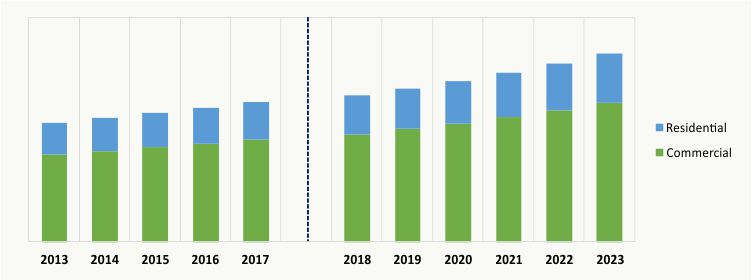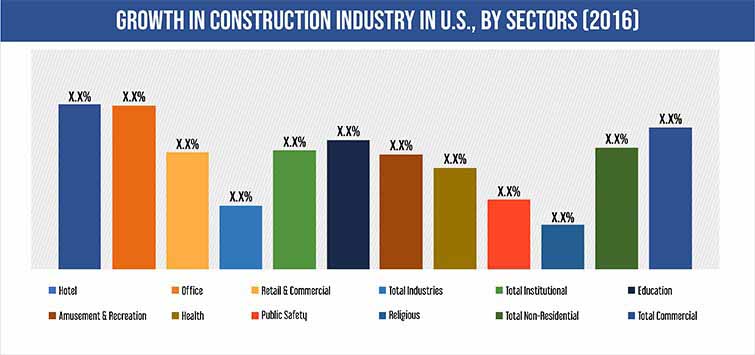Report Code: 11400 | Available Format: PDF | Pages: 112
Self-Levelling Concrete Market by Type (Underlayment, Toppings), By End User (Commercial, Residential), by Geography (U.S., Canada, Italy, Germany, Spain, France, U.K., Russia, China, Japan, South Korea, Taiwan, India, Brazil, Mexico, Argentina, Saudi Arabia, South Africa) - Global Market Size, Share, Development, Growth, and Demand Forecast, 2013-2023
- Report Code: 11400
- Available Format: PDF
- Pages: 112
- Report Description
- Table of Contents
- Market Segmentation
- Request Free Sample
Self-Levelling Concrete Market Overview
The global self-levelling concrete market is estimated to account for $5,000.3 million in 2017 and is projected to witness a CAGR of 5.1% during the forecast period. Self-levelling concrete, also known as self-levelling product, is widely used in commercial and residential constructions to level out and smoothen the entire floor area. The market growth is driven by the growing requirement for renovation and repair of schools, hospitals, offices, apartments, and malls. It is a mixture of powder and water that has exclusive flow viscosity, which allows the material to spread on its own on the floor before setting.
GLOBAL SELF-LEVELLING CONCRETE MARKET, BY END USER, $M (2013-2023)

On the basis of type, the self-levelling concrete market is segmented into underlayment and toppings. Underlayment has been holding a larger share in the market, with an estimated contribution of more than 75.0% in 2017. Underlayments help in minimizing surface irregularities and imperfections, which is promoting its growth in the residential and commercial sectors.
In terms of end user, the self-levelling concrete market is segmented into commercial and residential sectors. The commercial end user has been holding a larger share in the market, with an estimated contribution of more than 70.0% in 2017. The large share of commercial sector can be ascribed to the increasing demand of self-levelling products from various commercial facilities, such as educational institutions, hospitals, and retail stores worldwide.
Asia-Pacific is expected to be the fastest growing self-levelling concrete market during the forecast period, with a CAGR of 6.1%. The high growth in the region is attributable to the increase in demand for self-levelling products from countries such as China, India, Japan, Taiwan, and South Korea. China is regarded as the construction capital of the world and the scale of construction in the country is continuously gaining momentum at a fast rate, which is further boosting the market growth in the region.
Self-Levelling Concrete Market Dynamics
The improvement in the properties of existing concrete materials is the major trend witnessed in the self-levelling concrete market. The major factors driving the growth of market are increase in growth of the construction industry, a shift from traditional methods of levelling to self-levelling products and rise in government initiatives for the development of public infrastructures. However, high cost of raw materials for the production of self-levelling products is expected to restrain the market growth.
Trends
The existing concrete materials require high consumption of water, need experts for handling, and have low tensile strength. The use of such concrete materials is least durable and causes opening of floor joints, laitance, and cracks in floor coverings. There have been taking place improvements in the properties of existing concrete materials to solve these flooring problems. Many companies in the market are undergoing extensive R&D in order to bring innovation to concrete and flooring materials. Hence, improvement in the properties of the existing concrete material is the major trend witnessed in the self-levelling concrete market.
Drivers
The traditional methods of floor levelling are labor intensive and require excessive use of water. This has resulted in a shift from traditional methods of levelling to self-levelling products in the market. Also, self-levelling products have several benefits over traditional concrete, such as eight times faster setting power and the ability to be walked on within few hours after setting. Hence, owing to the several benefits of self-levelling products over traditional methods of flooring, its adoption is increasing, which in turn is fuelling the self-levelling concrete market growth.

Restraints
The high cost of raw materials required for self-levelling products is one of the major challenges witnessed in the self-levelling concrete market. The materials required for self-levelling products such as polymer-based compound, and spreader are expensive. Apart from this, the grout material is added during the self-levelling process in order to fill the area beneath the slab across holes drilled through the surface. This also increases the cost of the process; thereby, hindering the market growth.
Self-Levelling Concrete Market Competitive Landscape
Some of the key players operating in the global self-levelling concrete market are Arkema Group, Saint-Gobain S.A., Duraamen Engineered Products Inc., Durex Covering Inc., ARDEX Group, LafargeHolcim Group, ACG Materials, Durabond Products Ltd., The QUIKRETE Companies, and CTS Cement Manufacturing Corporation.
Want a report tailored exactly to your business strategy?
Request CustomizationWant an insight-rich discussion with the report author?
Speak to AnalystOur dedication to providing the most-accurate market information has earned us verification by Dun & Bradstreet (D&B). We strive for quality checking of the highest level to enable data-driven decision making for you
Our insights into the minutest levels of the markets, including the latest trends and competitive landscape, give you all the answers you need to take your business to new heights
With 24/7 research support, we ensure that the wheels of your business never stop turning. Don’t let time stand in your way. Get all your queries answered with a simple phone call or email, as and when required
We take a cautious approach to protecting your personal and confidential information. Trust is the strongest bond that connects us and our clients, and trust we build by complying with all international and domestic data protection and privacy laws